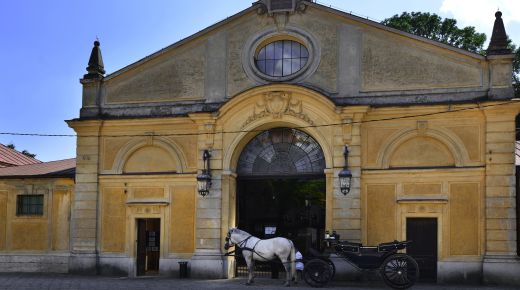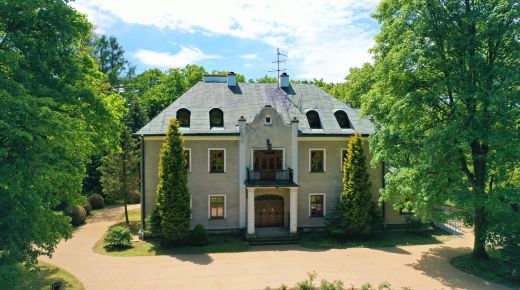The convent was built in the early 17th c in a place where a small wooden church was standing. Because the building was placed outside Rzeszów’s fortifications there was a necessity to fortify it
The Bernardine Convent in Rzeszów
Parish of the Assumption of the Blessed Virgin Mary in Rzeszów
Sokoła 8
35-010 Rzeszów
phone: 17 853 34 95
e-mail: sanktuarium1513@gmail.com
Surrounded by ponds and earthworks it became a North-West bastion of Rzeszów’s fortifications. After long building, when the convent was ready it was handed over to Bernardines. A century later the cloister was built anew. It was designed by the leading Baroque architect Tylman of Gameren working for the Lubomirski family.
The interior of the church is top-ranked among sacral monuments in Poland. Attention catching are: the 15th c Mother of God figure, the late Renaissance Main Altar in form of triptych with one of the greatest Mannerism artwork in Poland: alabaster bas-relief Deposition form the Cross by Jan Pfister, the marble-alabaster Saint Cross Altar made before 1629, the wooden Rococo choir and organ front with the instrument made in 1774. Mikołaj Spytek Ligęza, the founder of the convent, chose it to be a place of the eternal peace for himself and his family. On the North wall there are the detailed sculptures of the founder, the founder’s father Mikołaj Ligęza, Zygmunt and Stanisław, and Hermolaus, Feliks and two Jans on the South wall. By the sculptures there is a plate with the inscribed text of privilege granted to the Ligęza family by the king Władysław III of Warna.
The convent is in the possession of two important relics. In 2011 the fragment of papal soutane blooded during the assassination attempt on May 13, 1981 and the fragment of the soutane the John Paul II was wearing daily, were given to Bernardines by the Vatican.
The most recent change to the look of the convent was in 2010-2012. Neighbouring parking was changed into ‘Bernardine Gardens’ in which the parish organizes the religious musical events. It is surrounded by a fence and closed for night time, the unhampered access is possible between 8 a.m. and 9 p.m.
Worth seeing in Rzeszów:
-
Fara church
-
Jan from Dukla monument
-
Mother of God Poland's Queen monument
-
Piarist former convent
-
Stanisław Konarski monument
-
PKO building (1906-1908)
-
Lubomirski castle
-
summer palace of the Lubomirski family
-
Art-Nouveau villa from 1903 at Pod Kasztanami avenue
-
Art-Nouveau villa from 1899 at Pod Kasztanami avenue
-
“Pod sową” villa from 1900 at Pod Kasztanami avenue
-
Jędrzejowicz family palace, hospital now
-
Jędrzejowicz family palace on Załęże built18/19th c.
-
city hall
-
brick houses from 19th c.
-
Esterka's house, Rynek 15
-
well at the city main square
-
Underground Tourist Route
-
District Museum
-
Etnographic Museum
-
Musem of the History of Rzeszów
-
Museum of Bedtime Cartoons, collection by Wojciech Jama
-
Diocesan Museum
-
Hunters Museum
-
Museum of the Technology and the Military
-
"Marysieńka" Shelter
-
Artur Malawski Philharmonic Hall
-
Wanda Siemaszkowa Theatre, old building of Gimnastic Association „Sokół”
-
Józef Szajna Gallery
-
building of Regional Public Library from 1890, formerly home to the district council
-
Bishops palace at Jałowego Street
-
Colonel Leopold Lis-Kula Secondary School
-
Cichociemnych Square with Józef Szajna’s sculpture entitled Passage in 2001,
-
Kazimierz Górski Square
-
Rzeszów Photo Gallery
-
BWA Contemporary Art Gallery
-
Holy Trinity Chapel
-
Old Cemetery
-
January Uprising statue built in 1886
-
Tadeusz Kościuszko monument
-
Juliusz Słowacki monument
-
Colonel Leopold Lis-Kula monument
-
General Władysław Sikorski monument
-
Jan Pakosławic monument
-
Tadeusz Nalepa monument
-
Damned Soldiers monument
-
Stanisław Nitka monument by the Wisłok River
-
Terror Victims monument
-
Jan Kochanowski breast
-
Prince Kazimierz Pułaski breast
-
Jerzy Popiełuszko monument
-
St. Jan Nepomucen monument
-
Marcin Lelewel Borelowski memorial plaque
-
Ignacy Łukasiewicz memorial plaque
-
a sculpture of a boy shooting from a sling
-
multimedia fountain
-
building of Voivodeship Office
-
circular pedestrian bridge
-
The Revolutionery Act monument
-
wall painting representing a scene from Deballage, Józef Szajna’s theatre performance, Sokoła 3
-
Rzeszów's view by Lubomirski family architect Karol Henryk Wiedemann made in 1762 r.
-
Castle bridge.
Photo: Krystian Kłysewicz



